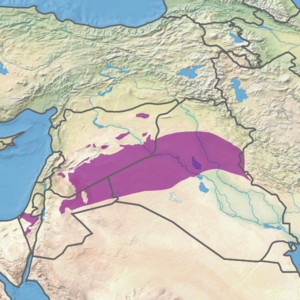Mesopotamian shrub desert
The Mesopotamian shrub desert is a deserts and xeric shrublands ecoregion in Western Asia. It extends across portions of Israel, Jordan, Syria, Iraq, and Iran.
| Mesopotamian shrub desert | |
|---|---|
 Baghdad-Amman_Higway | |
 Map of the ecoregion | |
| Ecology | |
| Realm | Palearctic |
| Biome | deserts and xeric shrublands |
| Borders | |
| Geography | |
| Area | 211,445 km2 (81,639 sq mi) |
| Countries | |
| Conservation | |
| Conservation status | Vulnerable[1] |
| Protected | 0.75%[2] |
Geography
The Mesopotamian shrub desert is a transitional region between the semi-arid steppes of the northern Mesopotamia and Levant to the north, and the Arabian Desert to the south.
The western portion of the ecoregion consists of rocky or sandy plateaus, including the Syrian Desert in southern Syria and northern Jordan, and a portion of the Harrat al-Sham black basalt desert in eastern Jordan. The eastern portion of the ecoregion includes central Mesopotamia, and the Tigris and Euphrates rivers run through it.[3]
Climate
The ecoregion has an arid subtropical climate. Rainfall averages 120 mm per year, concentrated in the winter months. Daytime temperatures often exceed 40° C in the summer months. Winters are cooler, and temperatures can fall below freezing on winter nights.[3]
Flora
Typical vegetation is dry shrubland. Shrubs include species of Artemisia, Anabasis, and Haloxylon. Perennial herbaceous plants include Achillea fragrantissima and Astragalus spp., and the grass Stipagrostis plumosa. Fast-growing ephemeral herbs sprout after rains, and quickly set seed before the succumbing to the summer drought.[3]
Poplar trees (Populus euphratica), reeds, and bulrushes are found in the seasonal and permanent wetlands along the Tigris and Euphrates rivers.
Fauna
Native mammals include golden jackal (Canis aureus), Rüppell's fox (Vulpes rueppellii), and striped hyena (Hyaena hyaena). Small populations of sand cat (Felis margarita), Arabian oryx (Oryx leucoryx) and Arabian sand gazelle (Gazella marica) are found in a few areas.[3]
The Syrian wild ass (Equus hemionus hemippus) once ranged across the ecoregion, but was hunted to extinction by the early 20th century.
Native birds include the mourning wheatear (Oenanthe lugens), and the Mesopotamian hooded crow (Corvus cornix capellanus) in Mesopotamia. The area around Lake Tharthar, a reservoir between the Tigris and Euphrates, is a wintering ground for several threatened birds, including the Saker falcon (Falco cherrug) and Houbara bustard (Chlamydotis undulata).[3]
Protected areas
Less than 1% of the ecoregion is in protected areas.[2] Protected areas include Azraq Wetland Reserve and Burqu Nature Reserve in Jordan, and Al-Talila Reserve in Syria.[3]
References
- "Mesopotamian shrub desert". Terrestrial Ecoregions. World Wildlife Fund.
- "Mesopotamian shrub desert". Digital Observatory for Protected Areas Explorer 4. Accessed 29 October 2020.
- "Mesopotamian Shrub Desert". One Earth, UNEP-WCMC Author Team. Accessed 29 October 2020.